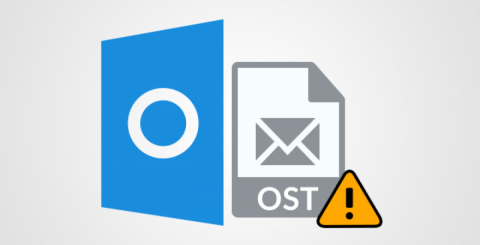OST File Not Recognized by Outlook 2016 / 2013 / 2010 – Error Solved

OST File Not Recognized by Outlook Error – All You Want to Know
Are you looking for the reliable solution to resolve the issue i.e., OST File Not Recognized by Outlook? Don’t be get panic, we are here to fix your .ost file difficulties. In this write-up, we try to give a perfect solution to users by which users can easily regain their OST data in Microsoft Outlook in a simple manner.
In the recent date, Microsoft Outlook is a boom for worldwide users. Also, it is one of the popular ways for the email communication and exchange of information. It has the advanced level of features; one of them its ability to synchronize with Exchange server. Whenever a user connects the Outlook with MS Exchange, it creates an OST file on the local system. Like many other files, the OST files are also prone to corruption. There are chances that this file may get damaged, which results in error Outlook 2016, 2013, 2010 does not recognize OST file. In such situations, the users look for a complete solution to get rid of this issue, but it is not an easy task to find any suitable method for the same.
Furthermore, it is really important to find a safe and secure solution to make the data accessible again. Thus, in this article, we will discuss some easy methods to resolve OST File Not Recognized by Outlook error message. But, before directly moving to the procedure, let us first find out the reasons behind it.
OST File Corruption Effects
Whenever users try to open Microsoft Outlook, and then they will get error messages or face more errors as mentioned below:
Outlook 2010, 2013, 2016 does not recognize OST file depending upon the versions of Microsoft Outlook users are accessing.
- The users cannot expand the folders. If they try to open a set of folders then, they get an error in the .ost file.
- A user cannot open an Outlook file. Encountered a large number of conflict items while offline cannot open an individual OST file.
Causes of OST File Not Recognized by Outlook Error
There are the two basic reasons for Outlook not recognizing OST file error:
- Damaged OST file due to some external factors such as virus attack, synchronization error, power failure or internal factors also such as the logical error.
- The second prominent reason is, sometimes, Outlook running on cached exchanged mode. Then, check if Outlook is running in cached Exchange mode, on the bottom right corner. The Outlook should read Connected To Microsoft Exchange and should not read Online with Exchange.
Fix OST File Not Recognized by Outlook Error with Manual Approach
Go through the following methods that will help to resolve the OST file error. Let us have a look:
- First, find the Outlook OST file, which is having the error. It is easy to find the file with help of the information that is mentioned in error message e.g (Outlook not recognizing OST file). Also, you can find the file by using the search feature of Windows OS.
- The users are advised to create a backup of the OST file as it will help them in making the data secure.
- You can also rename or delete the OST file which is causing the issue.
- In case, the MS Exchange mailbox and Email account are valid then, check Microsoft Outlook Account setting.
Note: The user needs to check that Outlook is connected to Microsoft Exchange properly.
- When the users checked all the settings, then they can start MS Outlook and send or receive emails on Exchange mailbox. Doing this will create a new OST file automatically and synchronize its data with the MS Exchange mailbox.
In some situations, MS Exchange mailbox or email account is not valid anymore. Then, you need to delete the current email profile and create a new profile to fix the Outlook does not Recognize OST File issue.
- First, you have to click on the Start button and then, go to the Control Panel.
- Now, press Switch to Classic View button if you are using Windows XP/higher versions.
- After this, (double-click) Hit on the Mail.
- Now, in the Mail Setup dialog box, click on the Show Profiles to fix the error: OST File Not Recognized by Outlook
- Select the incorrect profile into the list and hit on the Remove button to delete it.
- After this, click on Add to Make a new profile and add the email accounts
- Now, start MS Outlook, this will disappear the problem
Disadvantages of Manual Approach
In order to resolve Outlook does not recognize OST file error, the manual method is not considered as the perfect option because these manual approaches always have some limitations associated with them. These are:
- The manual approach is lengthy and confusing also.
- Non-technical users can find this process difficult to perform.
- It is time-consuming.
Simple Way to Fix Outlook 2016, 2013, 2010 Does Not Recognize OST File Error
It is possible that manual methods get fail to resolve Outlook not recognizing OST file error problem. Therefore, in such situations, users can opt for a third party tool, namely Outlook OST to PST Conversion Tool. This software is specially designed to repair damaged or corrupted OST files in a proper way. However, in this way, helps in the rectification of the error. The application maintains the integrity of the entire throughout the whole process.
Cessation
OST File Not Recognized by Outlook is an error that a user can encounter any time while using Microsoft Outlook. As mentioned above, the reasons behind the error are damaged and corrupted OST files. Hence, to repair .ost files users can go for the above mentioned manual method. In case the manual methods fail they can go for an automated solution i.e., Outlook 2016, 2013, 2010 does not recognize OST file and fix the error.
Similar Articles
Data recovery is the process of salvaging data from failed, corrupted or inaccessible storage media devices. These storage devices may include hard disks such as external hard drive or internal hard disk, DVDs, CDs, Raid, USB flash drive, SSD or storage tapes.
The headlines of Cyber attacks hit on a daily basis and the threat of it is rapidly expanding and transforming. As people are more connecting to the technology in different field and industry including large corporations like banks, governments, and small businesses as well as individuals, the threat is growing as per the opportunities.


